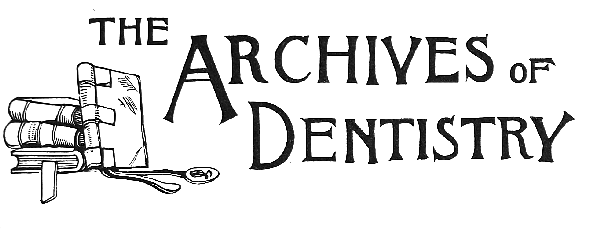
The cover image was created by the transcriber and is placed in the public domain.
[Pg 145]

THE ARCHIVES OF
DENTISTRY
SUCCESSOR TO
Missouri Dental Journal, also Consolidated with New England Journalof Dentistry.
Vol. VII., No. 4.] APRIL, 1890. [New Series.
Societies.
BLEACHING TEETH.
BY DR. K. M. FULLERTON, CEDAR FALLS, IOWA.
The bleaching of teeth has, from the first introduction of apositive method, been met with remarkable indifference and, attimes, positive prejudice. Why this should be will remain aproblem. The teeth that require bleaching belong mostly to aclass condemned for all purposes except that of mastication.The process is generally only applicable to the six anteriorteeth, while possibly an occasional bicuspid may be treated withadvantage. When these anterior teeth, especially the incisors,are discolored, they are such a positive disfigurement that theoperator has only the choice of evils—to bleach or to excisethem, and insert an artificial crown. It would seem no difficultmatter to come to a decision, or at least to determine to give thenatural tooth a chance for future usefulness.
The fear of re-discoloration, or annoying labor, should not betaken into consideration. All operators are liable to meet with[Pg 146]sudden discoloration in the regulating of teeth by the strangulationof the pulp at the apical foramen. When this occurs, itis one of the most humiliating of accidents, as it is one of themost annoying to patients. Discoloration is caused by decomposition,through a slow disintegration of the organic materialand the deposit of carbonaceous matter. It therefore followsthat the products producing color are not necessarily taken intothe tubes by imbibition, though doubtless, to a limited extent,this is the case, but are produced by local degeneration throughputrefactive processes. This change, though very slow in producingresults, eventually gives to the tooth the bluish tinge, orto a tooth long affected by decomposed matter, the dirty,bluish-yellow. It is unnecessary to enter minutely into the moreremote causes of discoloration, but we may summarize them asfollows:
1st. When death of a tooth is caused by a blow, attacks ofcaries, too rapid pressure in regulating teeth, etc., the deathand devitalization are followed by imbibition of coloring matterthrough the largest diameter of the tubules and local discolorationof the tube contents in the minuter anastomosing conduits.These changes may occur in teeth affected by caries, or withoutany external evidence of disease.
2d. The more aggravated cases, when this color has changedto a bluish-yellow, involving the entire structure of the dentine.
3d. Of the latter class, there may be a further subdivision,in which these are complicated with periosteal lesions whichmore or less interfere with efforts at restoration to originalcolor.
The necessity of making some effort to restore the color of teethchanged by devitalization was apparent to dentists very earlyin the present century. The constant destruction of pulpswi